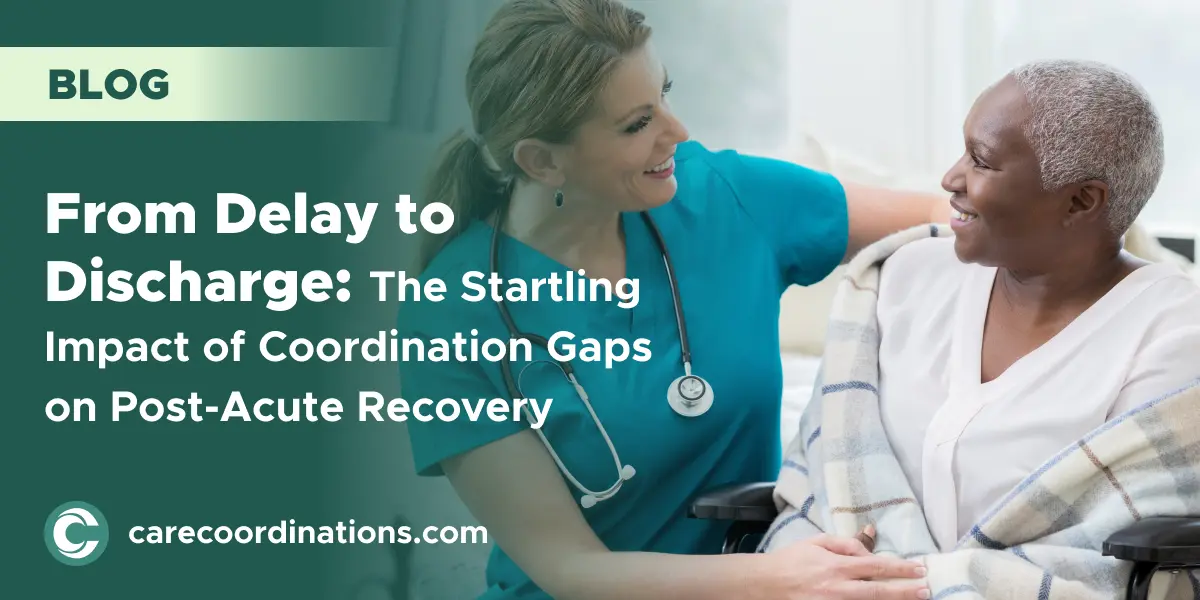In an age of increasingly complex healthcare systems, seamless transitions in care cannot be overstated. The journey from acute medical treatment to full recovery involves multiple stages, each requiring careful coordination to ensure successful patient outcomes.
However, gaps often exist in this coordination, leading to delays, increased healthcare costs, and considerable distress for patients and their families.
Research indicates that effective coordination in post-acute care settings can reduce hospital readmission rates by up to 25%. Also, streamlined coordination of care improves patient outcomes and significantly lowers healthcare costs, highlighting the critical role of seamless care transitions in achieving a sustainable healthcare system.
This blog explores the pivotal role of coordination in healthcare, highlighting the challenges and potential solutions within post-acute recovery processes.
Understanding Post-Acute Recovery
Post-acute recovery refers to the period of healthcare services that follow an initial acute phase of illness or injury. This stage is designed to help patients regain strength, health, and functionality and typically involves various forms of rehabilitation, home health care, and outpatient services. Effective post-acute care is crucial as it bridges the gap between hospital discharge and return to daily life, significantly impacting long-term health outcomes.
Did you know that nearly 20% of patients experience adverse effects within three weeks of discharge due to issues like medication errors, procedural complications, or infections? Many of these could be prevented with better coordination between healthcare teams during and after discharge.
Challenges in Post-Acute Care
Patients in post-acute recovery often face numerous hurdles, including navigating multiple healthcare providers, dealing with inconsistent care plans, and accessing necessary rehabilitation services. These challenges can complicate recovery paths and adversely affect outcomes by increasing the likelihood of complications, rehospitalization, and prolonged health issues.
Also Read: Uncovering the Financial Impact of Poor Care Coordination in Post-Acute Settings
The Role of Coordination in Healthcare
What is Healthcare Coordination?
Healthcare coordination involves the deliberate organization of patient care activities and information sharing among all participants concerned with a patient's care to achieve safer and more effective care. This includes seamlessly aligning health services and patient needs across the entire care continuum.
Barriers to Effective Coordination
Several factors often hinder effective healthcare coordination:
- Communication failures: Miscommunications between caregivers and patients can lead to inconsistent follow-ups and misunderstandings about care plans.
- Fragmented healthcare systems: Disparate healthcare systems often do not efficiently share patient information, leading to redundant procedures and gaps in care.
- Lack of standardized protocols: With universal protocols, transferring care from one facility to another can be problematic, making it easier to maintain continuity and quality of care.
Identifying Coordination Gaps
Identifying coordination gaps in the healthcare system is essential for improving patient care and streamlining recovery processes. These gaps can significantly impact the quality and efficiency of a patient’s care during their post-acute recovery phase.
Common Coordination Gaps
-
Between Acute Care and Rehabilitation Services:
Miscommunications and information delays are common during hospital transitions to rehabilitation or home care, often resulting in recovery setbacks and increased readmissions.
-
Among Healthcare Providers:
Diverse healthcare teams, such as physicians, specialists, and therapists, may need to communicate effectively, which can lead to duplicated efforts and inconsistent care.
-
In Access to Necessary Resources:
Logistical issues in securing medical equipment or specialist appointments can hinder a patient’s recovery, particularly when navigating complex insurance or geographic constraints.
-
Technological Disparities:
Variations in technology adoption between facilities can create inconsistencies in patient management, complicating care continuity.
-
Cultural and Linguistic Barriers:
Cultural differences and language barriers can prevent effective communication, affecting patient understanding and engagement in their treatment plans.
Identifying and Addressing the Gaps
Addressing these gaps involves regular audits of coordination processes, targeted training for healthcare providers, and investments in interoperable technology that facilitates better communication and data sharing. Healthcare systems can improve outcomes and enhance the overall patient experience during post-acute recovery by focusing on these areas.
Also Read: Unveiling How Inefficient Care Coordination Cripples Post-Acute Outcomes
Impact of Coordination Gaps
On Patient Health
Coordination gaps can significantly delay recovery, expose patients to higher risks of complications such as infections or readmissions, and impede healing.
On Healthcare Systems
Inefficient coordination increases healthcare costs through redundant care and extended treatment courses. It also places additional stress and workload on healthcare workers, contributing to burnout and reduced quality of care.
On Society
The broader economic implications include lost productivity and increased disability claims. Socially, the strain on families and caregivers and patient suffering represent significant yet often overlooked costs.
Strategies to Bridge Coordination Gaps
Technology Solutions
- Electronic Health Records (EHRs): Enhancing the use of EHRs can facilitate better data sharing and management across different healthcare providers.
- Telehealth services: Telehealth can provide continuous monitoring and management without the need for physical appointments, bridging gaps, particularly in rural or underserved areas.
Policy and Management Approaches
- Integrated care models: Models such as the Patient-Centered Medical Home (PCMH) and Accountable Care Organizations (ACOs) encourage holistic and coordinated care delivery.
- Training and development for healthcare workers: Education on the importance of coordination and training on using new coordination tools and protocols can improve care delivery.
Community and Patient Involvement
- Educating patients and families: Ensuring that patients and their families are well-informed about their care processes can help them to be active participants in their recovery.
- Community-based support systems: Leveraging community resources to provide additional support and coordination can alleviate systemic pressures.
Also Read: What Are the Core Benefits of Hospice Care for Patients and Families?
Take the first step towards better healthcare coordination today!
Gaps in healthcare coordination represent a critical barrier to efficient recovery and optimal health outcomes. Addressing these issues through technology, policy reform, and community engagement has the potential to enhance the efficacy of post-acute care.
Healthcare software solution providers, policymakers, and patients must work together to foster improvements that lead to more resilient, effective, and compassionate healthcare systems. The path forward requires commitment and innovation, but the benefits of bridging these gaps are profound and far-reaching.
Let us move towards a future where every transition in care is smooth, and every recovery pathway is clear.


